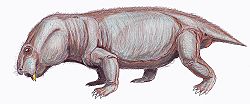This article relies largely or entirely on a single source .(May 2024) |
| Emydopidae Temporal range: | |
|---|---|
| Scientific classification | |
| Domain: | Eukaryota |
| Kingdom: | Animalia |
| Phylum: | Chordata |
| Clade: | Synapsida |
| Clade: | Therapsida |
| Suborder: | † Anomodontia |
| Clade: | † Dicynodontia |
| Superfamily: | † Emydopoidea |
| Family: | † Emydopidae Van Hoepen, 1934 |
| Genera [1] | |
Emydopidae is a family of dicynodont therapsids.





